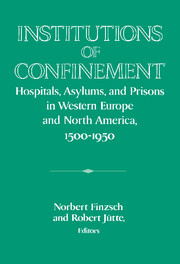 Institutions of Confinement
Institutions of Confinement Published online by Cambridge University Press: 05 January 2013
A philosopher produces ideas, a poet makes poems, a pastor sermons, a professor summaries and so on. A criminal produces crimes.... The criminal not only produces crimes, but also the criminal law and with it the professor, who gives lectures on criminal law, and above that [the criminal produces] the indispensable summary, through which the same professor infuses his lectures as “commodity” into the general market.... The criminal furthermore produces the whole police and criminal justice, the catchpoles, judges, hangmen, jurors etc.; and all these different trades... develop different abilities of human imagination, create new demands and new ways of satisfying those [demands]....The criminal produces... art, literature, novels, and even tragedies...
Few quotations from Karl Marx's writings demonstrate more clearly how low one can sink into a theoretical pit in order to explain the existence of crimes, criminality, and a penal system from the perspective of the state. Taken literally and transferred onto the field of the history of confinement in general, Marx's aperçu would mean not only that the criminal produced the prison, but that the patient created the hospital and the mentally ill invented the insane asylum. Being a trained jurist, Marx of course had a theory on crime and criminality, but it tended to be explicit only in areas such as property law, whereas the lower classes- les gens sans feu et sans aveu, the classes dangereuses, or the Lumpenproletariat - were nothing more than aberrant proletarians who had sunk into what Marx called the bohème. He even speaks of “this passive rot of the lowest strata of the old society” and predicts that, at best, this part of society has a tendency to form an alliance with reactionaries.
To save this book to your Kindle, first ensure [email protected] is added to your Approved Personal Document E-mail List under your Personal Document Settings on the Manage Your Content and Devices page of your Amazon account. Then enter the ‘name’ part of your Kindle email address below. Find out more about saving to your Kindle.
Note you can select to save to either the @free.kindle.com or @kindle.com variations. ‘@free.kindle.com’ emails are free but can only be saved to your device when it is connected to wi-fi. ‘@kindle.com’ emails can be delivered even when you are not connected to wi-fi, but note that service fees apply.
Find out more about the Kindle Personal Document Service.
To save content items to your account, please confirm that you agree to abide by our usage policies. If this is the first time you use this feature, you will be asked to authorise Cambridge Core to connect with your account. Find out more about saving content to Dropbox.
To save content items to your account, please confirm that you agree to abide by our usage policies. If this is the first time you use this feature, you will be asked to authorise Cambridge Core to connect with your account. Find out more about saving content to Google Drive.